The best way to describe the book, On Your Own in the Wilderness is that of a modern-classic. Written by Colonel Townsend Whelen and Bradford Angier in 1958, you can really feel Whelen’s influence from the days of Classic Camping. Although Whelen, famous for the Whelen Lean-To (future article here) and contributions to shooting ballistics, had some thoughts about his contemporaries (such as Nessmuk) and questioned their time afield. There should be no doubt to Whelen’s experience from his writings and reputation. Interestingly, it is reported that Whelen and Kephart corresponded. At a minimum, Whelen had to deal with Kephart’s popularity…
From the jacket cover of my 1964 edition:
Here is the camping and woodcraft handbook that takes up where Horace Kephart left off 40 years ago. No wonder critics hail it as “The Modern Kephart!”
I couldn’t agree more and recommend this book if you can 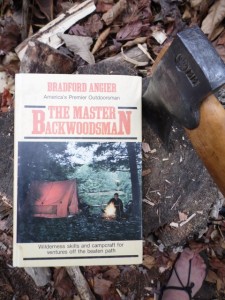 find a copy. You truly get a feel for Whelen’s reading of the classics, but it is mixed with the new age of plastics, nylon and a whole lot of experience. Angier also brings real world experience from a time in our recent history when men had time to do extended trips. In fact, if you are interested or can’t find a copy of On Your Own, Angier’s The Master Backwoodsman would also be a great addition to your library.
find a copy. You truly get a feel for Whelen’s reading of the classics, but it is mixed with the new age of plastics, nylon and a whole lot of experience. Angier also brings real world experience from a time in our recent history when men had time to do extended trips. In fact, if you are interested or can’t find a copy of On Your Own, Angier’s The Master Backwoodsman would also be a great addition to your library.
While On Your Own in the Wilderness came out in 1958, it was printed until at least the late 70’s, although I heard some of the later printings did not have some of the chapters on hunting. Here is the Table of Contents from 1964 to give you a better idea of the book:
Chapter 1 Lure of the Trail
Chapter 2 Outdoor Outfits and Outfitters
Chapter 3 Three Great Camping Areas
Chapter 4 The Most Imperative Vacations
Chapter 5 The Two Good Hiking Packs
Chapter 6 Hunter’s Pack
Chapter 7 Camping Without A Tent
Chapter 8 Tents for Wilderness Campers
Chapter 9 More Tents and Materials
Chapter 10 Stoves for Tents and Shelters
Chapter 11 The Campfire
Chapter 12 The Bedtime Story
Chapter 13 Tools for Outdoorsmen
Chapter 14 Footwear for Wilderness Trails
Chapter 15 Mosquitoes, Flies, et al
Chapter 16 Taking Care of Yourself
Chapter 17 Always Knowing Where You Are
Chapter 18 Maps and Mapping
Chapter 19 Automobile and Motorboat Camping
Chapter 20 Paddle, Pole, and Portage
Chapter 21 Saddle and Picket Rope
Chapter 22 Women in the Woods
Chapter 23 Pothunting and Hunting Methods
Chapter 24 Furs, Trophies, and Rawhide
Chapter 25 For the Good of the Venison
Chapter 26 Meats for Outdoorsmen
Chapter 27 Provisioning for Camping
Chapter 28 Bread Over Open Fires
Chapter 29 Basic Outdoor Cookery
Chapter 30 Water and Washing

Something in Chapter 11, The Campfire, piqued my interest, specifically an opportunity for Master Woodsman readers to have some fun. You can count on me bringing this up on my next camping trip with friends!
B’iling The Kittle
“The northern woodsman, particularly the Canadian, must sip his steaming cup of tea at noon and contemplate its rapidly changing surface colors even if he has nothing to eat. This is almost religion up under the Aurora Borealis and is called “b’iling the kittle.” For the temporary fire required, nothing elaborate is needed. Sufficient is a handful of dry wood that will flare up briefly and as quickly disintegrate to ashes, a few grey feathers of which invariably swirl up to float almost unnoticed in the dark brew.”“The Campfire Club for more than forty years has sponsored an annual competition in boiling a kettle of water, with prizes and with time limits for qualification. The participant is given a billet of dry wood about five by twelve inches, a sharp hand ax, a kettle holding about two quarts of water and one match. That is all.”
“The best technique is first to split the wood to include three full length pieces about three-fourths of an inch thick. These three sticks are driven into the ground to form a triangle about six inches high upon which the kettle is set. The remainder of the wood is reduced to shavings and split kindling which are placed under the kettle and ignited. If the competitor is experienced, he has picked up a small dry pebble on which to strike his match, and he kneels facing the wind. I know of no quicker way to boil tea water than this.”
“Your woodsman is not so elaborate. He builds a fire in the easiest way he can, depending on what fuel there is at hand. He cuts a green pole several feet long. This tea stick he shoves into the ground so that one end extends over the center of the heat. He may adjust its height by propping it up with a rock or chunk of wood.”
“The kettle he hangs by its bale at the end of the tea stick. This container, incidentally, is very often a large enough tin can near whose rim opposite holes have been punched and a handle, perhaps a foot of light copper or snare wire, inserted.”
For fun and prizes, Master Woodsman will do an online version of The Campfire Club’s B’iling The Kittle. Stealing one of our mentors (Steve Watts) lessons because the name better explains it, we will call it the “One Billet Boil Up.” And as Steve points out why he has taught this exercise; it brings knife, axe, and firecraft into one exercise.
So using only one billet of wood approximately 5″ x 12,” a hatchet, small axe and/or knife as a cutting tool, a kettle with one quart of water, and one match; submit your pictures and/or video and we will post them in a separate article called One Billet Boil Up. The first ten with the fore mentioned included in their email sent to info at masterwoodsman dot com with the subject of One Billet Boil Up will be sent a Made in the USA 22″ x 22″ Master Woodsman 100% cotton bandana (must be in the U.S. or Canada).
Bonus points for cool gear in your photos and/or video!
CONSIDERATIONS
This is an inherently dangerous activity as you will be using a sharp, short-handled tool. Thus, I feel obligated to state, no one is making you do this challenge and we aren’t liable if you cut off a digit or worse. Think twice, cut once. The reason we are calling this a challenge and not a competition is it’s really more of a race to provide a submission. If this were a true competition we would all be in the same place/conditions, using the same species of wood, etc. Good luck and be safe!
UPDATED. From this past October’s Camp-Fire Club water boil event. Thank you Shawn! Nice skills!
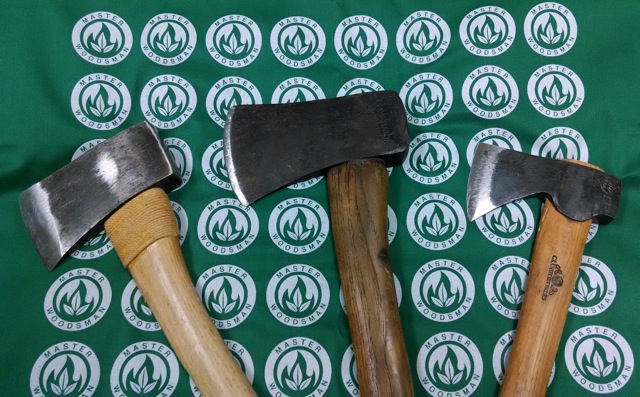
Hatchets left to right. Vintage Snow & Nealley, my father’s COMPANION USA-M, Granfors Bruks Mini-Hatchet.



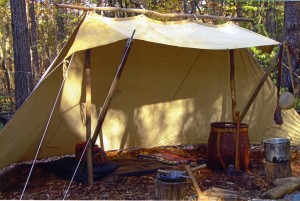
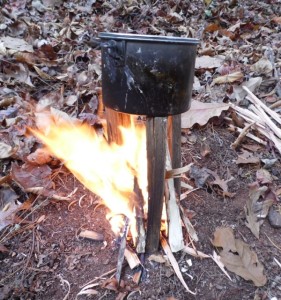
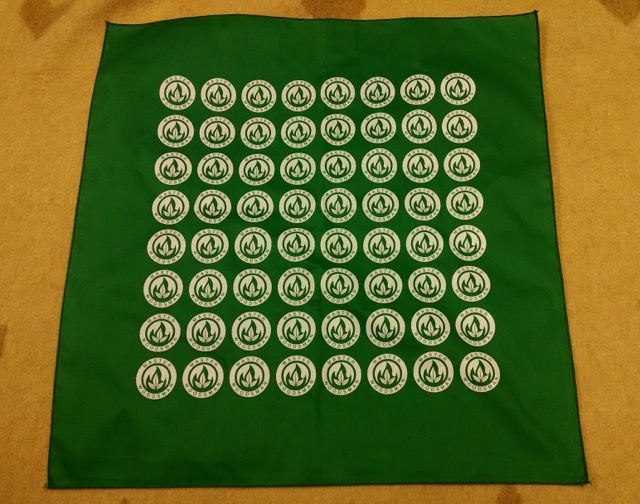
5 Responses to On Your Own in the Wilderness (and Challenge)